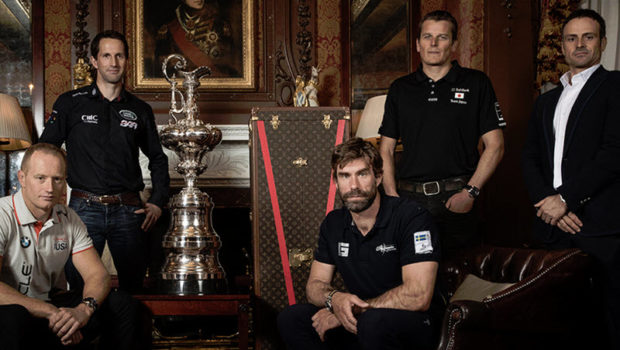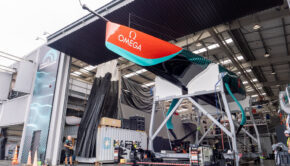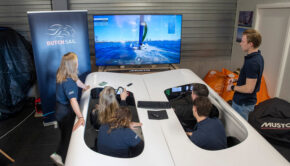A Future Vision for the America’s Cup
Published on January 25th, 2017
(January 25, 2017) – A vision for the future of the America’s Cup has been agreed by five of the six competing teams in the 35th edition for the oldest trophy in international sport.
During a press conference at The House of Garrard in London, United Kingdom where the America’s Cup trophy was originally crafted in 1848, representatives from these five teams revealed a framework agreement that would cover the next two editions, the 36th and 37th America’s Cup, due to take place in 2019 and 2021 respectively.
Racing in the 35th America’s Cup will take place in Bermuda in May/June of this year and the 36th America’s Cup cycle would commence thereafter.
The framework agreement and agreed future protocol binds the signatories to deliver the 36th America’s Cup (AC36) and the 37th America’s Cup (AC37) under the following terms:
• The America’s Cup will be on a two-yearly cycle for AC36 (2019) and AC37 (2021).
• The America’s Cup World Series (ACWS) will start, at the election of the defender, as soon as Q4 2017. Venues, sponsors and media partners will be approached over the next six months to secure up to 12 international events over the next two years.
• The first year of the America’s Cup World Series (ACWS) will be raced in AC45F foiling catamarans – the same boats used in America’s Cup World Series (ACWS) in the 35th America’s Cup.
• The second year will see a transition to the America’s Cup Class (ACC) boats, the same technically sophisticated class of boats raced in Bermuda in 2017 (with a slight rule modification to extend the wind range in which they can race to 4 to 26 knots). After this transition to the America’s Cup Class (ACC), the AC45Fs will be retired from the America’s Cup competition and the ACC boats will be the only boats raced.
• The America’s Cup World Series (ACWS) will culminate with a final event at the venue for the next America’s Cup and the final standings from the America’s Cup World Series (ACWS) will be used to qualify teams for the America’s Cup Challenger Playoffs.
• The America’s Cup Challenger Finals and America’s Cup Match will be held in 2019 in a venue selected by the winner of the 35th America’s Cup.
• To reduce costs, teams will not be permitted to build, test or train on AC45 surrogate boats as they have in this cycle of the America’s Cup.
• This above will repeat for AC37, with the exception that all racing will take place in America’s Cup Class (ACC) boats.
There is no mention of a nationality clause within the framework agreement.
Five of the six current competitors and their respective yacht clubs have already signed this framework agreement: ORACLE TEAM USA, Artemis Racing, Team France, Land Rover BAR and SoftBank Team Japan.
However, the missing team in the agreement is challenger Emirates Team New Zealand, and until all six teams entered in AC35 approve the terms, all bets are off.
“Emirates Team New Zealand is not here today, but they have been kept updated on all developments throughout the creation of the framework agreement,” said Martin Whitmarsh, the CEO of Land Rover BAR, a challenger for the 35th America’s Cup. “We remain optimistic that they will come on board in the future and it is clear that cooperation is better for all of the stakeholders in the America’s Cup.”
As is required, the framework agreement respects and upholds all aspects of the Deed of Gift, the document that lies at the heart of the America’s Cup.
The Deed of Gift is the foundational document governing the America’s Cup. One of the unique aspects of the competition is that after winning the racing on the water, the victorious yacht club and its team then become the trustees of the event, responsible for outlining the terms of the next edition.
As a result, if Emirates Team New Zealand does not approve of the agreement, and they win the 35th America’s Cup Match in 2017, they are driving the bus and have no obligation to this framework agreement.
Historically, this has seen a crescendo of interest in the America’s Cup as the final races take place, followed by an extended period of down-time during which the new Defender re-defines the equipment and format of the next event, and builds a business structure to manage the next edition of a major, globalized, international competition, all while maintaining its core focus on winning as a sports team. This has resulted in teams being disbanded and costly equipment being made redundant and discarded.
The framework agreement provides stability, which will assist in maximizing the commercial interests of the event, and enable prospective teams to better understand the commitment needed to compete. It establishes a modern sporting, technology and design challenge, within which costs are controlled to provide a much lower entry price, which will encourage more teams to be involved and ultimately create larger audiences.
“The target cost to field a competitive new team is in the US$30-40 million range, a significant reduction from current team budgets,” reports Whitmarsh.
“It’s important for the teams to know what the future of the America’s Cup is and that is now clear with this agreement,” Franck Cammas, Skipper of Team France. “That is good for everyone, commercially and for long-term planning.”
Iain Murray, Regatta Director of the 35th America’s Cup said, “There’s a void to be filled and the overwhelming message from all the people in the America’s Cup is let’s grab this opportunity and run with it.”
Dean Barker, CEO and Skipper of SoftBank Team Japan endorsed the sheer spectacle that is America’s Cup racing in its modern guise: “It’s high octane, seat of the pants racing with plenty of action and plenty of drama. It can be very unpredictable but it’s a true test of machines, technology and people and the racing now is a hell of a lot better than it’s ever been before.”
“This agreement is about a format long overdue in competitive sailing,” noted Torbjörn Törnqvist, Artemis Racing’s Team Founder and Principal. “The boats and the racing are incredibly exciting to watch – whether you are a sailor yourself or not. This will now reinforce the America’s Cup as the world’s supreme grand prix racing for sailing.”
Jimmy Spithill, the skipper of two-time winner and current defending champion, ORACLE TEAM USA said, “We have all seen how damaging that extended quiet period can be for each of the stakeholders in the event. What we’ve done over the past year is to work together to tackle that problem head-on.
“We know that one of the current teams is going to win, so we have found common ground on a vision for the next event, and formalized that into rules now, before racing starts later this year. That means there is now a clear plan in place that confirms the format for the competition using existing boats and equipment as much as possible to reduce costs.
“I think this announcement will go down as one of the defining moments in America’s Cup history. It’s great for fans, athletes, and commercially – a win win for everyone. This is a huge step forward, with the sky the limit.”
But again, this agreement only has traction if all teams approve the terms. As long as the Kiwis don’t, any talk about the future of the America’s Cup beyond the 35th edition is a vision and not an iron clad plan.
Source: ACEA, Scuttlebutt
Editor’s note: The cozy relationship of the defender and challengers is certainly at odds with the history of the event, and concerning this framework agreement, NZ Herald’s chief sports reporter Dana Johannsen has wasted no time to call bullsh#t on the plan. Full report.
Background: The 35th American’s Cup has attracted six teams (5 challengers and 1 defender) that will compete in the new 15-meter AC Class, with a series of qualifiers beginning on May 26, 2017 that lead to the start of the America’s Cup Match on June 17, 2017. Complete schedule.









 We’ll keep your information safe.
We’ll keep your information safe.